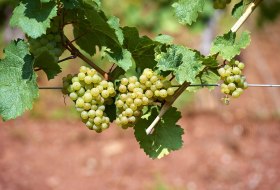Riesling. A promise for best white wines. With Riesling, every winemaker gets the chance to show what they are capable of doing. In Rheinhessen, Riesling covers 18% of the vineyard area and with 4.969 ha it is the most important grape variety. And it continues to increase.
The Riesling matures slowly. In order to form the typical aromas, the grapes must remain stay on the vine for a long time. Under the relatively cool climatic conditions at the 50th parallel, Riesling can develop its fine fruit flavors, complete its maturity in the late autumn sun and express its fresh acidity. Riesling is a grape variety, that can expose the unique character of the terroir magnificently. World famous Rieslings are from "Roter Hang" (Red slope) between Nierstein and Nackenheim - it is the Riesling hotspot on the Rhine terrace.
Worms scores with the famous Riesling location Liebfrauenstift-Kirchenstück, representing outstanding wine culture in Germany.
On the steep "Scharlachberg" in Bingen, fascinating Rieslings grow on the only quartzite soil in Rheinhessen. The "Wonnegau" and the "Hügelland" have excellent Riesling vineyards on limestone soils, for example in Westhofen (Morstein, Kirchspiel), Flörsheim-Dalsheim (Hubacker), Saulheim (Hölle) or in Appenheim (Hundertgulden), on the border to Nahe with Porphyry in Siefersheim (Heerkretz) or on the marl soils in "Selztal" (Hahnheimer Knopf, Stadecker Spitzberg).
First indications of the Riesling in Rheinhessen are more than 500 years old. The first mention of Riesling in Rheinhessen was on November 11, 1511 in Worms Pfeddersheim, reporting a vineyard in Pfeddersheimer St. Georgenberg (known as "Fohndel" before). This also is the oldest documentation of a vineyard site Riesling in Germany.



